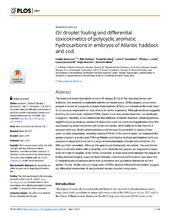| dc.contributor.author | Sørensen, Lisbet | |
| dc.contributor.author | Sørhus, Elin | |
| dc.contributor.author | Nordtug, Trond | |
| dc.contributor.author | Incardona, John P. | |
| dc.contributor.author | Linbo, Tiffany | |
| dc.contributor.author | Giovanetti, Laura | |
| dc.contributor.author | Karlsen, Ørjan | |
| dc.contributor.author | Meier, Sonnich | |
| dc.date.accessioned | 2017-08-16T07:46:31Z | |
| dc.date.available | 2017-08-16T07:46:31Z | |
| dc.date.issued | 2017-07-05 | |
| dc.Published | Sørensen L, Sørhus E, Nordtug T, Incardona JP, Linbo T, Giovanetti, Karlsen ØK, Meier S. Oil droplet fouling and differential toxicokinetics of polycyclic aromatic hydrocarbons in embryos of Atlantic haddock and cod. PLoS ONE. 2017;12(7):e0180048 | eng |
| dc.identifier.issn | 1932-6203 | en_US |
| dc.identifier.uri | https://hdl.handle.net/1956/16292 | |
| dc.description.abstract | The impact of crude oil pollution on early life stages (ELS) of fish, including larvae and embryos, has received considerable attention in recent years. Of the organic components present in crude oil, polycyclic aromatic hydrocarbons (PAHs) are considered the main class of compounds responsible for toxic effects in marine organisms. Although evidence suggests that they are more toxic, alkylated PAHs remain much less studied than their unsubstituted congeners. Recently, it was established that embryos of Atlantic haddock (Melanogrammus aeglefinus) are particularly sensitive to dispersed crude oil, and it was hypothesized that this was caused by direct interaction with crude oil droplets, which adhered to the chorion of exposed embryos. Such a phenomenon would increase the potential for uptake of less water-soluble compounds, including alkylated PAHs. In the current study, we compared the uptake of parent and alkylated PAHs in Atlantic cod (Gadus morhua) and haddock embryos exposed to dispersed crude oil at a range of environmentally relevant concentrations (10–600 μg oil/liter seawater). Although the species are biologically very similar, the cod chorion does not become fouled with oil droplets, even when the two species are exposed to dispersions of crude oil droplets under similar conditions. A close correlation between the degree of fouling and toxicological response (heart defects, craniofacial malformation) was observed. Oil droplet fouling in haddock led to both quantitative and qualitative differences in PAH uptake. Finally, kinetic data on a large suite of PAHs showed differential elimination, suggesting differential metabolism of unsubstituted versus alkylated compounds. | en_US |
| dc.language.iso | eng | eng |
| dc.publisher | PLoS | en_US |
| dc.rights | Attribution CC0 | eng |
| dc.rights.uri | https://creativecommons.org/publicdomain/zero/1.0/ | eng |
| dc.subject | Hyse / Haddock | eng |
| dc.subject | Metabolisme / Metabolism | eng |
| dc.subject | PAH / PAH | eng |
| dc.subject | Torsk / Cod | eng |
| dc.title | Oil droplet fouling and differential toxicokinetics of polycyclic aromatic hydrocarbons in embryos of Atlantic haddock and cod | en_US |
| dc.type | Peer reviewed | |
| dc.type | Journal article | |
| dc.date.updated | 2017-07-11T20:13:11Z | |
| dc.description.version | publishedVersion | en_US |
| dc.rights.holder | This is an open access article, free of all copyright, and may be freely reproduced, distributed, transmitted, modified, built upon, or otherwise used by anyone for any lawful purpose. | en_US |
| dc.identifier.doi | https://doi.org/10.1371/journal.pone.0180048 | |
| dc.identifier.cristin | 1481732 | |
| dc.source.journal | PLoS ONE | |
| dc.relation.project | Norges forskningsråd: 234367 | |
| dc.subject.nsi | VDP::Matematikk og naturvitenskap: 400 | |
| dc.subject.nsi | VDP::Mathematics and natural scienses: 400 | |

